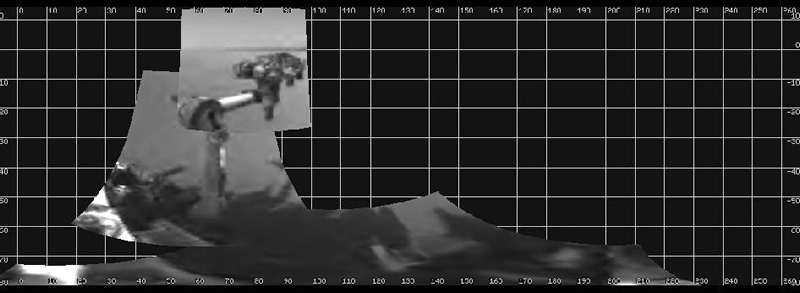Curiosity Stretches its Arm
Curiosity Stretches its Arm

NASA's Mars rover Curiosity extended its robotic arm on Aug. 20, 2012, for the first time on Mars and used its Navigation Camera (Navcam) to capture this view of the extended arm. Image credit: NASA/JPL-Caltech
August 20, 2012
Mars Science Laboratory Mission Status Report
PASADENA, Calif. -- NASA's Mars rover Curiosity flexed its robotic arm today for the first time since before launch in November 2011.
The 7-foot-long (2.1-meter-long) arm maneuvers a turret of tools including a camera, a drill, a spectrometer, a scoop and mechanisms for sieving and portioning samples of powdered rock and soil.
"We have had to sit tight for the first two weeks since landing, while other parts of the rover were checked out, so to see the arm extended in these images is a huge moment for us," said Matt Robinson of NASA's Jet Propulsion Laboratory, lead engineer for Curiosity's robotic arm testing and operations. "The arm is how we are going to get samples into the laboratory instruments and how we place other instruments onto surface targets."
Weeks of testing and calibrating arm movements are ahead before the arm delivers a first sample of Martian soil to instruments inside the rover. Monday's maneuver checked motors and joints by unstowing the arm for the first time, extending it forward using all five joints, then stowing it again in preparation for the rover's first drive.
"It worked just as we planned," said JPL's Louise Jandura, sample system chief engineer for Curiosity. "From telemetry and from the images received this morning, we can confirm that the arm went to the positions we commanded it to go to."
The image of Curiosity's arm is online at http://1.usa.gov/OSyG3B.
The turret has a mass of about 66 pounds (30 kilograms). Its diameter, including the tools mounted on it, is nearly 2 feet (60 centimeters).
"We'll start using our sampling system in the weeks ahead, and we're getting ready to try our first drive later this week," said Mars Science Laboratory Deputy Project Manager Richard Cook of JPL.
Curiosity landed on Mars two weeks ago to begin a two-year mission using 10 instruments to assess whether a carefully chosen study area inside Gale Crater has ever offered environmental conditions favorable for microbial life.
JPL, a division of the California Institute of Technology, Pasadena, manages the Mars Science Laboratory Project, including Curiosity, for NASA's Science Mission Directorate, Washington. JPL designed and built the rover. The Space Division of MDA Information Systems Inc. built the robotic arm in Pasadena.
(credits: JPL - NASA - All rights reserved)
